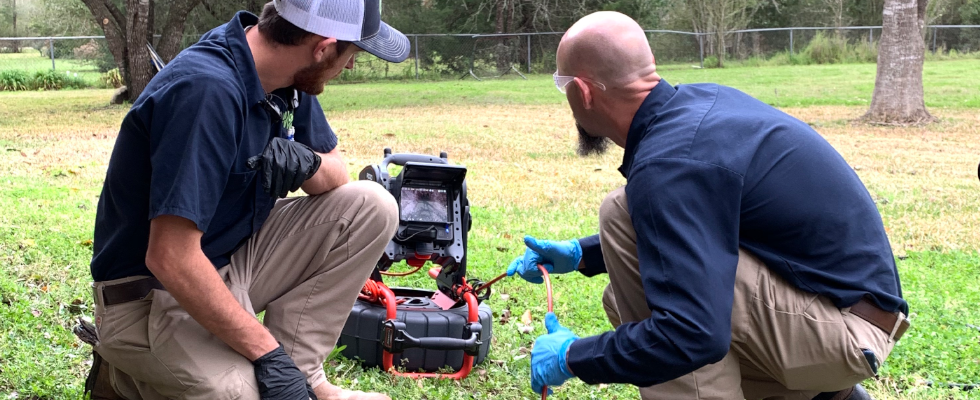Do you have a permanent wet spot or muddy patches in your yard? These are classic signs of poor yard drainage – meaning the soil is retaining too much water. So, what could be causing these drainage problems?
Leading Causes of Yard Drainage Problems
Several factors cause a yard to have drainage problems. Here are some of the most common reasons your yard is draining poorly.
- Front walkways – If a sidewalk sits in front of your house, it may be blocking off the water and preventing it from running through your yard and into the storm drain.
- Yard slope – When there’s little or no slope in the yard, water collects and stands instead of running off.
- Impacted soil – Construction projects around the house, such as in-ground pools, can cause impacted soil and result in drainage problems.
- A too-short downspout – If your gutter’s downspout aims straight into a flower bed or other landscaped areas, excess water can collect in the mulch and soil underneath.
- Runoff erosion – The runoff from your downspout may have stripped away some of the topsoil in your yard – which can lead to a heavy collection of water under the eroded area.
Two Yard Drainage Solutions – French Drain and Trenchless Drain
Once you identify what is causing your drainage issue, one of these simple solutions should help you dry things up!
What is a Trenchless Drain?
If you need to update your home’s drainage system, you may assume that means you’ll have to dig up your beautifully manicured lawn. What if we told you there’s another way?
Thanks to modern trenchless drain technology, your underground pipes can be replaced with very little damage to your yard.
How Does Trenchless Drain Technology Work?
- A camera is used to identify issues. A special camera is run through your kitchen, laundry, or sewer lines so your technician can actually see what’s going on.
- Technicians access the line. Your plumber will dig two small holes at the beginning and end of the pipe being replaced. Once the small holes are dug, a cable is inserted at one end and fed through using a pneumatic jack.
- The old pipe is replaced with the new one. The bursting head is attached to the new pipe and pulled through the old sewer line. As it’s pulled through, the new pipe slides into place and breaks away the old pipe.
What are the Benefits of Trenchless Drains?
- Keeps your landscaping intact. Only two small holes are dug in your yard, so your grass and landscaping aren’t destroyed.
- Saves money and time. The method itself is about 40% cheaper – and you don’t have to pay for excavation and re-landscaping.
When Do You Need a Trenchless Drain System?
- When you’re working with pipes that run underground (under your home, landscaping, or apartment).
- When your water pipes are broken and cracked due to the house settling or earth movement.
- Your sewer pipes have burst from blockages due to debris in the lines or tree roots.
- Your pipes are damaged from repeated freezing and thawing.
- If you experience persistent leaks or sewer backups due to improperly installed pipes.
- You need a larger water line to accommodate your household needs better.
What is a French Drain?
French drains regulate water at ground level, much like water gutters collect precipitation as it runs off your roof.
The name may sound fancy, but it doesn’t come from France. It’s named after a judge and farmer in Concord, Massachusetts, Henry French, who promoted the idea in an 1859 book about farm drainage.
How do French Drains Work?
Water always flows downhill – and takes the easiest path possible. A French drain allows water to run into a gravel-filled, slightly sloped trench, then out of a perforated pipe at the bottom of the trench.
Water flows freely through the pipe and empties away from the house – eliminating standing water and puddles in your yard.
What are the Advantages of French Drains?
- Dry out lawns that are too wet or moist. Standing water in your yard prevents you from using it for play areas or landscaping. It also makes mowing more difficult.
- Prevent water damage to your foundation. French drains effectively channel water away and help keep your foundation dry.
- Inexpensive to install and doesn’t require heavy equipment or expensive tools.
When Do You Need a French Drain?
- When you have standing surface water that doesn’t drain, leaves your yard soggy, or washes out a driveway, walkway, or landscaping.
- If water gets into your foundation or basement.
- If you want to build a retaining wall on a slope or hillside.
Having Yard Drainage Problems? Malek Plumbing is Ready to Help! Malek Plumbing provides professional residential and commercial plumbing services in College Station, Bryan, and throughout Central Texas. Our licensed plumbers will evaluate your situation and offer prompt and reliable solutions to solve your plumbing problems. Contact us today at 979-431-4949 or schedule an appointment online.
